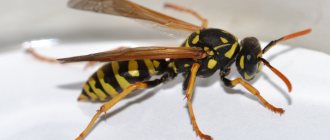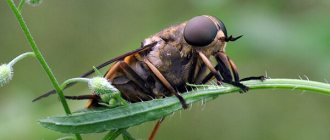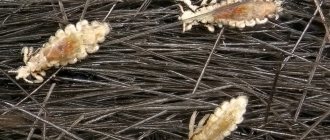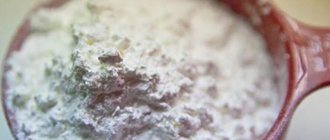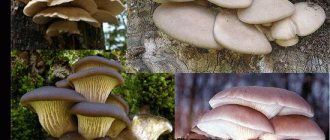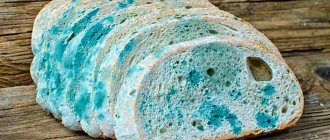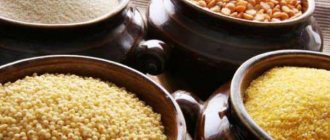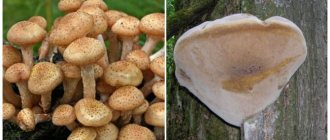Differences between saprophytes and parasitic microorganisms
In life, parasitic and saprophytic bacteria are very difficult to distinguish, even when using a large knowledge base and special equipment.
This is due to the fact that parasites often lead a semi-saprophytic lifestyle, that is, they adapt to the environment and begin to consume half-life products. Usually, they are distinguished by external characteristics (look at the photo to see how saprophytes differ from parasitic bacteria). Hence the need to create subclasses:
- Facultative parasitic bacteria. They are also called semi-saprophytes, or parasites of conditional origin. They usually lead a parasitic life, but when necessary they attack still diseased plants.
- Facultative saprophytes (conditional saprophytes/hemiparasites). They are characterized by behavior similar to the life activity of facultative parasites, only they refuse live food.
Consequently, some saprophytes do not feed exclusively on carrion and rot, in which they are similar to parasites that do not consume a purely living substrate, but the main thing is that they do not harm healthy plants and environments.
Symbiont mushrooms
Symbiosis is the cohabitation of different organisms in which both benefit. Symbiont fungi participate in the formation of two symbioses:
- lichens formed as a result of interaction with algae and bacteria;
- mycorrhiza - with the root system of plants.
Nutritional Features
Mushrooms, entwining the small roots of plant organisms, feed on the organic substances that make up their composition. Such actions do not harm plants, but promote the absorption of nutrients (nitrogen, phosphorus, microelements) and water from the soil.
Names and descriptions of popular symbiont mushrooms
Usually referred to as a mixed type of nutrition, which can receive organic substances from both plant roots and humus.
- Boletus. Interacts with oaks, willows and poplars. The brown hemisphere-shaped cap has a reddish or orange tint. It is impossible to separate the layer of skin without pulp. The height of the gray leg is up to 18 cm. The fruit body is fleshy and dense. Young individuals are elastic, while old ones become loose. At the break, the white flesh turns blue over time and then turns black. Does not have a pronounced aroma.
- Boletus. Grows near birch roots. Over the course of its life, the mushroom cap changes from a spherical shape to a flat, pillow-like shape. At high humidity it becomes sticky to the touch. The white pulp with a dense structure oxidizes at the cut site. In older individuals it becomes watery and loose. Cylindrical leg covered with dark gray scales.
- and saffron milk cap. They live under coniferous trees. Butterflies are characterized by a slimy skin that appears to be coated with oil. Hemisphere-shaped hats reaching 16 cm in diameter are painted in a spectrum of colors from brown-chocolate to yellow-brown. As they grow older, the shape straightens out, becoming flat. The color of the stem is usually lighter. The pulp is juicy. The saffron milk cap is characterized by a round cap with concentric circles and a depressed center. The orange pulp oxidizes when it comes into contact with air, acquiring a greenish tint.
If you destroy the host tree, the mushrooms growing underneath will also disappear.
What types of saprophyte mushrooms are there?
Representatives of the genera Penicillium and Mucor cause food spoilage
The variety of saprophytes is surprising. The names of the most famous:
Mukor: This is a lower mold fungus. Included in the class Zygomycetes. It is aerobic, that is, existence is impossible without oxygen. The mycelium of mucor is unicellular, has many nuclei. All representatives of this genus settle in the upper layers of soil, horse manure, food and organic debris. The body of this organism looks like thin threads - this is a mycelium. On the branches or hyphae of the mycelium, small black heads grow, which contain spores. Mucor feeds on organic matter. The scavenger mushroom, as it is also called, because it does not leave waste. Mucor can also appear on a living, but sick organism. When he dies, all the remains are processed.
Aspergillus: a mold fungus belonging to the higher aerobic species. The genus of these organisms has hundreds of species. All of them are quite common and grow in different climate zones. They take root on various substrates and create fluffy white colonies. But over time the color changes. Aspergillus has strong mycelium and septa. It reproduces, like other saprotrophs, by spores. The organism lives in soil, which contains a lot of oxygen. The organism appears as mold on top of the substrate. This particular mushroom is dangerous. It affects products that contain starch. The organism grows inside and on the surface of the tree.
Penicillium: these representatives of higher fungi are not uncommon in nature. They belong to imperfect fungi. Of particular value is the green racemose mold - penicillium aureus. The widely known antibiotic penicillin is produced from it. Penicillium lives in the soil. The structure is similar to that of the Aspergillus fungus. The vegetative mycelium is branched, colorless and multicellular. This (structure) of the penicillium fungus differs from mucor - the latter has a protozoan mycelium. The hyphae of the organism are immersed in the substrate or located on its surface. Erect conidiophores form brushes that carry chains of spores. These chains have from one to three tiers and can also be asymmetrical. These fungi reproduce by spores. It is saturated by absorbing organic matter. Some representatives are weak plant parasites. The development of penicillium leads to food spoilage.
Life activity of parasites
Almost the entire life of parasites passes inside another organism; they not only live in it, but also feed on living cells. It could be a plant, an animal, a person - in other words, just the owner.
Anything can become a source of parasite infection. Sometimes it is enough to eat an unwashed fruit or vegetable, and the parasite eggs will end up inside the body. This often happens when in contact with animals, because most of them are carriers of parasites.
The fact of infection is not only unpleasant, but can also be dangerous, because if left untreated, very serious complications can occur, even death.
The main difference - Saprophytes vs Parasites
Saprophytes and parasites are two forms of life that follow a heterotrophic mode of nutrition. This means that saprophytes and parasites cannot produce their own food. The main difference between saprophytes and parasites is that saprophytes rely on dead and decaying organic matter for their nutrition, while parasites are completely dependent on the other organism for their nutrition. Saprophytes are mainly fungi and bacteria. They play a key role in ecosystems by releasing nutrients from dead matter into the soil. Parasites can be unicellular or multicellular animals or plants. Protozoa, helminths and ectoparasites parasitize humans. Rafflesia and Cuscata are parasitic plants.
Key areas covered
1. What are saprophytes - definition, characteristics, role, examples2. What are parasites - definition, characteristics, role, examples3. What are the Similarities Between Saprophytes and Parasites - Brief Description of Common Features4. What is the difference between saprophytes and parasites - Comparison of the main differences
Key words: bacteria, decomposers, ectoparasites, fungi, helminths, heterotrophs, parasitic plants, parasites, protozoa, saprophytes
Main differences between saprophytic fungi and parasites
It is incorrect to assume that any microorganisms that feed on organic food are parasitic. Parasites include those organisms that survive at the expense of others. They can settle both inside a body and outside.
Saprophytes feed only on the remains of plants or animals. These include soil and mold fungi, as well as mold bacteria. Thus, the main differences between saprophytes and parasites are several features:
- Method of existence and nature of nutrition of organisms: parasitic individuals feed on the organic structures of a living host; saprophytes live on dead plant bodies.
- Unlike parasites, saprophytes usually do not cause harm to the human body.
- The habitat for saprophytes can be both living and non-living structures. Parasites live only in a living organism.
In some cases, fungi turn from parasites into saprophytes, which initially settle on living plants, and after their death continue to live, feeding on dead wood. Such fungi are called symbionts.
Division of living beings according to type of nutrition
Every living organism requires the supply of certain substances or energy from outside to ensure its existence. The process of consuming these resources is called nutrition.
According to the method of nutrition, all living organisms are divided into two types:
- autotrophs;
- heterotrophs.
Autotrophs are organisms that are capable of independently producing the organic substances they need from inorganic ones. These include most plants that obtain their food from carbon dioxide and water using solar energy.
Heterotrophs are creatures that need ready-made organic substances. This is a huge group of living organisms, within which there are many more classifications. Heterotrophs are divided into biotrophs and saprotrophs. The former feed on living organisms: animals or plants. These also include parasites that have adapted to a life where their host is both food and home for them.
Saprotrophs, on the other hand, obtain food from dead creatures or their secretions (including excrement). This group includes bacteria, plants, fungi (saprophytes) and even animals (saprophages). They, in turn, are also divided into different subgroups: detritivores (feeding on detritus), necrophages (consuming animal corpses), coprophages (feeding on feces) and others.
Types of nutrition of living organisms
Based on the method of extracting biological compounds, there are 2 types of nutrition of living organisms: autotrophic and heterotrophic.
Autotrophs are creatures that themselves are capable of producing organic compounds from minerals. Another name for this group is producers.
There are 2 types of autotrophs:
- phototrophs that build their cells using the energy of sunlight;
- chemotrophs that use chemical compounds (sulfur, iron, hydrogen sulfide, methane).
The first group includes plants, the second - prokaryotic communities. Some bacteria are classified as mixotrophs, since they use light energy and in the dark feed on ready-made organic compounds.
Heterotrophs are creatures that cannot independently produce the necessary compounds from minerals and require food from the outside. This group includes:
Heterotrophs are divided into biotrophs and saprotrophs. Saprotrophs obtain nutrition from the destruction of excrement, carrion, and plant remains. Another name for this category of creatures is saprophytes.
Biotrophs obtain the necessary compounds from living beings, destroying them immediately or by parasitizing them for a long time. This group includes:
- zoophagous - feed on animals;
- phytophages - use plants as food;
- bacteria.
- autotrophs and heterotrophs
The meaning of mushrooms in nature
Nutrients decomposed by mushrooms are subsequently absorbed by other plants. Living creatures (animals and insects) feed on cap species. There are also mushrooms that are specially grown artificially. These are champignons and oyster mushrooms. Mold fungi (aspergillus, penicillium) are used to produce antibiotics and even hard cheeses. Ergot (formed on cereal crops) is used to combat malignant tumors.
Many parasitic fungi cause harm to living organisms and plants, causing diseases. Considerable damage is caused to wood. It is not recommended to use contaminated building material for wooden buildings.
Since the mushroom culture can cause fatal poisoning, experts advise collecting it with great caution.
Life activity of parasites
Parasites spend almost their entire lives inside another organism and feed on its living cells. The plant or animal within which the bacterium lives and whose cells it feeds on is usually called the host. Parasitism is a relationship between one type of living organism (parasite) and another (host), during which the first lives and feeds at the expense of the second.
Viruses
Viruses are parasites that do not show any signs of life while outside the cell of a living organism. Due to the fact that viruses themselves do not have a cellular structure, they also do not produce energy, do not feed, do not grow, and are not capable of metabolism. Being outside a living cell, viruses are similar to inanimate matter, but there are two properties that distinguish them:
- The ability to reproduce, that is, to reproduce forms similar to oneself.
- Heredity and variability.
The life cycle of the virus consists of the following stages:
- Penetration into a living cell.
- A change in metabolism inside the cell, causing the production of viral nucleic acids and proteins.
- Self-assembly of the virus inside the cell from produced viral acids and proteins.
- From an overabundance of newly formed viruses, the cell dies
- Viruses leave the host cell.
By colonizing human and animal cells, viruses provoke the development of many dangerous and sometimes fatal diseases.
Comparison
If we compare these two microorganisms with each other, then initially it should be said that their life routine is almost the same. In some cases, these microorganisms become very difficult to distinguish. The fact is that some parasites can behave in the same way as saprophytes. And saprophytes can use for living and further nutrition living organisms that have been greatly weakened due to the onset of illness.
In order to understand how to distinguish these microorganisms, some comparison should be made:
- Saprophytes, which have the ability to pass themselves off as parasites, develop without the help of another living organism. After some time, they become completely safe for the human body, but only if they are not affected by negative factors. This species is of great importance in the cycle of substances.
- The conditional type of parasitic forms can live just like an ordinary parasite, but at the same time the nutrition will occur like that of saprophytes. But this happens before full maturity, and then the parasites take root in the tissues and already fully lead their parasitic lifestyle.
- Obligate parasites. This type uses exclusively living cells for its nutrition, and after they die, the cells die along with these bacteria. Throughout their entire life cycle, bacteria lead an exclusively parasitic lifestyle.
Taking into account the information received, it can be noted that both presented forms of microorganisms can equally cause harm to humans. Only saprophytes also provide certain benefits.
In any case, the detection of any of these types of organisms requires immediate treatment.
Animals are saprophytes. What it is?
Among the representatives of the fauna there are also similar organisms. For example, saprophytic mites (arachnids). These arthropods are not directly dependent on other organisms, but still need ready-made organic compounds. They use decaying plant or animal tissues for their nutrition. More than 150 species of dust mites are saprophytes, some of them are considered allergenic. They can only be seen under a microscope, since their sizes are minimal (average - 0.2 mm). The animal's lifespan is about four months. During this time, the female tick manages to lay up to 300 eggs. And just one gram of dust can “house” up to several thousand of these organisms. They eat scales of the skin layer of people, which are present in abundance where a person sleeps (according to science, a person can shed up to 700 grams of dead skin particles per year, and saprophytic dust mites feed on them).
Parasites, viruses, bacteria and humans
Viruses, parasites, bacteria - all these microorganisms had a direct impact on human evolution. And yet, microorganisms benefit humans, despite the harm they cause.
Help of microorganisms to humans
Ten facts about how parasites, viruses and bacteria help humans:
- . Thanks to modern science and genetics, it is now reliably known about who infected our ancestors, which subsequently turned out to be an evolutionary impetus.
- Use of larvae and leeches. European leeches have been used in medicine for many years. But due to the evolution of germ theory, their use has ceased in many countries. But later cosmetologists and surgeons returned to them. Leeches get rid of a swollen face, black eyes, and help with the reattachment of body parts (ears, skin, etc.). In addition to leeches, their larvae are also effective, so thanks to them a separate industry has emerged - biotherapy.
- Parasites and the immune system. Parasitic therapy is parasitic, since negative outcomes still prevail over positive ones. However, one cannot ignore the successful consequences. Intentional infection with parasites can relieve neurological, allergy and other diseases. And this has been proven through experiments carried out by a large number of scientists.
- Virotherapy. This therapy involves introducing a reprogrammed virus into a person. Thus, some viruses were transformed to treat cancer, measles, and tumors.
- Viruses for the treatment of bacterial infections. Bacteriophages are viruses that hunt bacteria. Bacteriophages change the metabolism of bacteria and in this way destroy it. Currently, certain diseases in humans are also treated with the help of phages.
- Vaccines are the same virus of a disease, but weakened, which is administered so that the immune system has an idea in advance how to compete with the disease.
- Recycling. Bacteria living in the surrounding world and feeding on dead cells of plants and animals benefit nature by clearing the earth of waste.
- . Without the bacteria naturally living in the gastrointestinal tract, a person might even die, since they help both digest food and work in tandem with the immune system, protecting life.
- Skin bacteria. Thanks to evolution, we are not born dead. And here's why - after leaving the mother's womb, the child is attacked by bacteria, and more specifically, the skin. Bacteria live on the skin from the very moment they appeared in this world and this is completely normal, because in a certain way they protect it from other harmful microorganisms.
- Cyanobacteria or algae are among the oldest microorganisms living on Earth. Thanks to algae, we and other living organisms appeared on our planet, since cyanobacteria are the first photosynthesizers. It was they who produced oxygen, vital for all life on our planet.
Many types of bacteria, viruses and parasites have their place in the living environment and have a unique purpose.
Saprotrophic fungi and parasites
When considering representatives of this kingdom, a person far from natural sciences will not always be able to say what exactly is the difference between the different species.
Saprotrophic fungi and parasites
The main difference between saprotrophic and parasitic fungi is the substrate they use as a food source. This trait determines their body size, habitat, number and method of distribution of spores.
Saprophytes
These creatures get their energy from dead organic matter. Saprophytes free the environment from the remains of plants and animals, decomposing them to form simple inorganic compounds. They return mineral salts to the soil, which will later be useful to plants.
The group of higher saprophytes includes such well-known representatives of the kingdom as:
- boletus;
- Champignon;
- morels and lines;
- fly agarics;
- dung beetles.
Among the known lower genera are yeast and penicillium. They have found their application in medicine and the food industry.
Saprophytes can cause harm. Thus, mushrooms of the genus Mukor, which form on stale bread, are dangerous for humans and animals. When they enter the body they cause mucormycosis.
Parasites
Unlike saprophyte fungi, parasites take nutrients from the host and can lead to its death. They settle:
- on plants;
- on animals;
- on a person;
- on other mushrooms.
Parasitic mushrooms
According to the degree of development and size, they are divided into 2 categories:
- Microparasites. Lower fungi that reproduce directly in the body and host cells. These include: slime mold, candida.
- Macroparasites. They spread by spores from one host to another. Typical representatives include enemies of agricultural plants: scab, late blight, cabbage sage, ergot, smut.
Among the macroparasites of animals and plants, fungi of the genera Trichophyton, Epidermophyton, and Microsporia are known. They cause infectious diseases.
Also among fungi there are species that manifest themselves as saprophytes and parasites. They use an atypical substrate when their habitat conditions change.
Saprophytes can feed at the expense of the host. This is how autumn or winter honey mushrooms settle on dead woody debris (stumps). But when mycelium spreads, they grow on damaged spruce, birch and aspen trees. In this case, the fungi begin to parasitize and worsen the condition of the living host.
Polypores are initially parasites. They grow on tree trunks. But after the death of the host, these mushrooms continue to live on them as saprophytes.
According to the type of nutrition, all organisms are divided into those who independently produce organic products from minerals, and those who are deprived of this ability. Representatives of the second group belong to saprophytes or parasites. One of them uses dead organic matter as a food source, others settle on living organisms. In nature there are mushrooms with different types of nutrition. Their mutually beneficial cohabitation with representatives of other kingdoms is also possible.
Saprophytic and pathogenic microbes
Based on the nature of their relationships with flora and fauna, microbes are divided into two groups: saprophytes and parasites.
Saprophytic microorganisms include microorganisms that primarily live on dead substrates. They do not cause diseases in humans, animals or plants. Saprophytes are widespread in nature. Many microbes have adapted to a parasitic lifestyle and have the ability to cause infectious diseases in animals and plants. These disease-causing microbes are called pathogenic.
Pathogenicity is a species characteristic of pathogenic microbes. Each type of microbe is capable of causing a specific infectious disease. For example, the tuberculosis bacillus causes tuberculosis, and the anthrax bacillus causes anthrax. However, individual strains of the same pathogenic microbial species have different pathogenic effects. The degree of pathogenicity of a microbe, the activity of its introduction into the body, the intensity of reproduction, the ability to produce various toxic substances that suppress the body’s defenses are usually called virulence. A measure of virulence is the minimum number of microbial cells, when introduced into the body, a fatal disease occurs.
At the same time, they talk about high and low virulence and avirulence of certain representatives of the same species. And depending on environmental conditions, the virulence of pathogenic microbes can increase, weaken and completely disappear.
It is possible to artificially change the virulent properties of microbes in the desired direction, which is of great practical importance. This is the basis for the production of live microbes with weakened virulence or live vaccines, which are successfully used to prevent infectious diseases.
Along with pathogenic ones, there is a relatively large group of microorganisms called opportunistic microorganisms. Under normal living conditions of an animal, these microbes do not cause disease, that is, they are saprophytes; however, when the body is weakened due to malnutrition, overwork, overheating, hypothermia, and intoxication, they become capable of causing disease and acquire high virulence. Thus, opportunistic E. coli can cause severe white diarrhea in newborns.
Saprophytes in nature
In nature, saprophytes are very important, because thanks to their participation, media of organic origin are processed, because any living organism (including plants) dies over time. For the same reason, saprophytes always have an object to feed on. In addition, thanks to the processing of organic waste, new components arise through their decomposition, which are subsequently used by other organisms, which provokes a kind of cycle of substances in nature.
Saprophytes mean a lot in nature, because their task is to transform chemical substances and mineralize them, from where fermentation, phosphorus, carbon, nitrogen and other useful processes, substances and minerals arise. Without these organisms, other, more developed creatures could not exist on the planet.
The concepts of bacteria and saprophytes are inseparable. The fact is that all living organisms in nature are divided into autotrophs and heterotrophs. Autotrophs can provide themselves with food on their own. Heterotrophs, on the other hand, need ready-made nutrients. Heterotrophs are divided into saprophytes, symbionts and parasites. This division of organisms allows us to study the living world in more detail. Each of these types of representatives of the bacterial world has its own meaning.
Features of saprophytes
Most representatives of the kingdom Bacteria are saprophytic. They are, to varying degrees, demanding of organic compounds, which are of great importance in the processes of their development and life. Bacteria are found in nature that can normally exist only in complex sources (substrates), for example, these can be putrefactive decomposing remains of plants and animals, milk, etc. Thus, for the life of bacteria, some essential nutritional components are necessary. Such substances are:
- nitrogen (or a set of amino acids),
- carbohydrates,
- proteins,
- peptides,
- vitamins,
- nucleotides (possibly components suitable for their synthesis, such as nitrogenous bases, five-carbon sugars).
To meet the needs of saprophytes in laboratory conditions, cultivation is carried out in media that contain plant extracts, whey, yeast autolysates, and hydrolyzed meat products.
Similarities between saprophytes and parasites and their differences
Saprophytes in nature lead a lifestyle similar to parasites. Moreover, it is sometimes problematic to clearly divide heterotrophic organisms into these two types, since some parasitic organisms in the process of life have behavior that is more reminiscent of semi-saprophytic.
Based on this, the need arose to isolate facultative parasites and saprophytes.
Facultative saprophytes (also called semiparasites or conditional saprophytes) are bacteria that develop in the absence of a living host organism. At some stages of their own development, they behave like saprophytes, while other situations are characterized by a predominantly parasitic existence. They have a limited range of potential hosts. Such microorganisms do not germinate well on nutrient media. However, they play an important role in the cycle of substances.
Facultative parasites (also called conditional parasites or semi-saprophytes) are bacteria that live according to the saprophytic type of nutrition. But under certain conditions or after reaching certain stages of development, they settle on the living tissues of weakened plants and lead a parasitic lifestyle.
Place of saprophytes in nature
The role of saprophytic organisms in the living world occupies a very important place. Most of them are needed in nature for the purpose of processing organic waste. Since the life course of any living organism ends with death, there is always food for saprophytes. Thus, they play the role of environmental health workers. Also, these bacteria are an important link in the cycle of organic substances, as they decompose dead tissue into components that are then used by other organisms.
The importance of these bacteria for the environment is not limited to the processing of organic matter. They are active participants in the processes of mineralization and transformation of chemicals. As an example of the participation of saprophytic bacteria in the cycle of substances, the following processes can be considered: the transformation of phosphorus, sulfur, nitrogen, carbon, fermentation processes.
Thus, the importance of saprophytic bacteria in the environment is quite high.
Saprophytes and parasites: what are they and how do they differ?
The environment contains a large number of various microorganisms (the collective name for small living organisms that can only be seen through a microscope), which have both positive and negative effects on humans and animals. These microorganisms include saprophytes and parasites.
Saprophytes - what are they?
Saprophytes are a group of microorganisms that feed on processed dead cells of living beings and process complex organic substances into simple inorganic substances. Thus, this microorganism is capable of providing significant benefits.
For normal existence, these bacteria require the following elements:
- Carbohydrates.
- Nitrogen in the form of a set of amino acids.
- Peptides.
- Squirrels.
- Vitamins.
- Nucleotides.
By feeding on dead cells, microorganisms have a cleansing effect on the human body , ridding it of toxins and improving overall well-being. Once in the human body, the microorganisms present can prevent the negative effects of parasites. They promote the breakdown of fiber, resulting in faster absorption of food.
These bacteria, being in the human body, do not cause any harm to him, but, on the contrary, bring benefit, albeit small.
But, unfortunately, under the influence of external factors, bacteria can begin to have a negative effect , provoking the occurrence of various diseases. This situation is explained by the fact that saprophytes also secrete waste products.
And it is these products that can be dangerous for the human body, because microorganisms feed on dead cells, which can cause various kinds of allergic reactions. For example, a type of bacteria such as E. coli can cause diseases such as meningitis, pneumonia, and sepsis.
All of these diseases are dangerous because they can be fatal.
The role of these bacteria in the life of humans and animals is quite important, since they are the ones who process the so-called waste. They even received the title of “body orderlies.”
In addition to all this, saprophytes, when feeding, break down dead tissue in such a way that there is enough to feed other organisms.
The most popular types of saprophytes include dust mites. It prefers to live on surfaces such as wood, pile, fabric, and feeds on dust, which consists of dead human skin cells.
Mukor
This representative belongs to the generic branch of lower mold fungi of the class zygomycetes. In total, the class includes 60 species of various mushrooms. They can be found in the top layer of the earth; they can develop on food and organic parts. A certain amount of mucor can cause disease not only in animals, but also in humans.
But there are a number of mushrooms that are intended for use in the production of antibiotics or as a starter. Only those mucor mushrooms that have high enzymatic activity are used in production.
Reproduction of mucor fungi can be asexual or sexual. In asexual reproduction, the shell of a mature mushroom quickly and easily dissolves from moisture, and several thousand spores come out. Two branches take part in sexual reproduction: homothallic and heterothallic. They unite with each other to form a zygote, after which a hypha with an embryonic sporangium begins to germinate. People use Chinese mucor and snail mucor as leaven. Many people call these mushrooms Chinese yeast.
Mucor can cause illness in humans and animals
How to destroy saprophytes
Let us emphasize right away that it is impossible to completely get rid of saprophytes, but you can regularly carry out proper cleaning/cleaning/washing, which will help reduce the concentration of dust mites in the air.
Experts give the following recommendations for the destruction of saprophytes:
- Pillows and blankets should be cleaned regularly. Even in winter, it is recommended to hang these bedding items outside - frost and wind will definitely clear them of dust, and at the same time get rid of dust mites. Please note: you may find advice to periodically expose all bedding to ultraviolet rays. Yes, saprophytes die under them, but the procedure should last at least 2 hours, since household ultraviolet emitters are low-power.
- Carpets and rugs need to be periodically cleaned/washed/washed in the sun. The procedure of “heating” these objects in the sun will also be effective - in the summer the air temperature rises, and dust mites cannot tolerate too hot air, or too cold air.
- Carrying out wet cleaning of the premises. Cleaning using a concentrated saline solution is allowed. To do this, you need to dissolve 10-15 tablespoons of salt in 8 liters of hot water, and then wash the baseboards, floors, and walls (if possible) with the resulting solution. There is only one nuance to take into account - the saline solution leaves marks on the surface after drying, so wet cleaning will have to be done twice, but it will be very effective.
- It is necessary to reduce the amount of furniture and interior items on which it will be convenient for saprophytes to fixate. We are talking about textiles, which should be in short supply in the premises. And if an allergic reaction in the form of bronchial asthma, rhinitis and other pathologies already exists, then carpets, tablecloths, and soft toys will have to be removed from everyday use. You can purchase an air ionizer - under its influence dust mites die, so you can not only maintain an acceptable atmosphere in the house for improving health, but also get rid of saprophytes as much as possible.
We should also talk about washing things - this is another way that helps to significantly reduce the concentration of saprophytes in the air. First, you need to wash all your laundry in the hottest water possible. You shouldn’t go to extremes - you still need to pay attention to what type of fabrics are put into the washing machine and whether hot water can be used for them. Secondly, there are a lot of detergents on store shelves that help destroy the tiny creatures in question. These include washing powders from the “Sarma” series - they do not contain chlorine and have an antibacterial effect, which has been officially proven and confirmed by certificates. Thirdly, after washing, it is advisable to dry things in the fresh air.
Saprophytes cannot be seen, they do not have any pronounced effect on humans, but it is reliably known that these small creatures can cause severe allergic reactions.
Differences between saprophytes and parasites
The difference between saprophytes and parasites is more obvious when considering the nature of existence and nutrition. So, fungi, microbes, parasites and saprophytes, characteristic differences:
| Parasites | Saprophytes |
| exist only at the expense of the carrier | do not feed on living organic matter |
| affect the host’s body in a negative way, causing infections, toxic poisoning | microorganisms and bacteria that rarely have a harmful effect on humans |
| existence requires a living host: fish, human, animal | enough non-living biological structures |
Regardless of their nature, bacteria, microorganisms, fungi, parasites and saprophytes can cause harm, so prevention, personal hygiene, caution in consuming raw food and other precautions will come in handy
Who are saprophytes?
To understand the difference between parasites and saprophytes, it is necessary to define what saprophytes are. These include microorganisms and bacteria, the food for which is the remains of plants and animals. The most popular representative of saprophytes is the dust mite. It can live on any surface (wood, lint, fabrics), and feeds on dust consisting of dead human skin cells.
Most saprophytes do not pose a danger to humans, but there are species that can cause serious illness if they enter organs and tissues. Such saprophytes include, for example, E. coli.
This type of bacteria is often found in decomposing animal carcasses, especially cattle. When E. coli enters the human body, organs become infected, which can result (depending on the location) in pneumonia, meningitis and even sepsis. All these diseases are dangerous for humans with a high risk of mortality, so it is important to monitor hand and skin hygiene and take measures to strengthen the immune system in the autumn and winter.
Important! Despite the fact that saprophytes do not feed on the tissues of living organisms, their food must still be of an organic nature (trees, rotting plants, animal carrion).
This means that chemicals and compounds are not suitable for this type of microorganism.
Saprophytic mushrooms
Mushrooms are the oldest inhabitants of the Earth, their history goes back at least one billion years. They are so unusual that for a long time biologists could not decide on their classification and did not know which kingdom to classify them in. Indeed, fungi have characteristics characteristic of both animals and plants. As a result, they were separated into a separate kingdom.
Fungi are single- or multicellular living heterotrophic organisms whose cells have a nucleus (eukaryotes). All mushrooms feed by absorbing ready-made organic substances from the environment, previously releasing special dissolving enzymes, i.e. digestion occurs outside the body.
Based on their feeding method, fungi are divided into three broad groups: parasites, saprophytes and symbionts. This division is also characteristic of other kingdoms. Parasites have become accustomed to life on other living organisms (or even inside them), feeding entirely on them. Among edible mushrooms, the parasite is the honey fungus, known to all of us.
Although symbiont mushrooms live at the expense of other organisms, they also benefit them by releasing necessary minerals and processing waste. Among them are porcini mushroom, boletus, butterfly, saffron milk cap, boletus, boletus and many others.
Fungi that feed on organic matter left over from dead animals and plants or their secretions are called saprophytes. Examples of such mushrooms that are familiar to us: morels, strings, champignons, puffballs. This category also includes a huge number of molds that affect food.
In order to provide themselves with the necessary nutrition as much as possible, all these mushrooms have the appropriate structure - long and powerful myceliums, completely immersed in a substrate edible for them.
Parasitic mushrooms
According to the degree of development and size, they are divided into 2 categories:
- Microparasites. Lower fungi that reproduce directly in the body and host cells. These include: slime mold, candida.
- Macroparasites. They spread by spores from one host to another. Typical representatives include enemies of agricultural plants: scab, late blight, cabbage sage, ergot, smut.
Among the macroparasites of animals and plants, fungi of the genera Trichophyton, Epidermophyton, and Microsporia are known. They cause infectious diseases.
Also among fungi there are species that manifest themselves as saprophytes and parasites. They use an atypical substrate when their habitat conditions change.
Saprophytes can feed at the expense of the host. This is how autumn or winter honey mushrooms settle on dead woody debris (stumps). But when mycelium spreads, they grow on damaged spruce, birch and aspen trees. In this case, the fungi begin to parasitize and worsen the condition of the living host.
Polypores are initially parasites. They grow on tree trunks. But after the death of the host, these mushrooms continue to live on them as saprophytes.
Definition
The word itself is borrowed from another language, more precisely, it is combined from two Greek words: sapros - “rotten” and phyton - “plant”. In biology, saprophytes are fungi, plants and bacteria that consume dead tissues of animals and plants as food, as well as products released by them during their vital activity. They are distributed everywhere - in water, land, air, and also in the bodies of living beings.
Most often, saprophytes are individuals that do not harm their owner. A person does not even realize what a huge number of different microorganisms are constantly on his skin and inside the body, without causing any diseases. However, under the influence of negative factors (decreased immunity, excessive increase in the number of microbes), everything can change, and saprophytes can cause an infectious disease.
Features of saprophytes
Most representatives of the kingdom Bacteria are saprophytic. They are, to varying degrees, demanding of organic compounds, which are of great importance in the processes of their development and life. Bacteria are found in nature that can normally exist only in complex sources (substrates), for example, these can be putrefactive decomposing remains of plants and animals, milk, etc. Thus, for the life of bacteria, some essential nutritional components are necessary. Such substances are:
- nitrogen (or a set of amino acids),
- carbohydrates,
- proteins,
- peptides,
- vitamins,
- nucleotides (possibly components suitable for their synthesis, such as nitrogenous bases, five-carbon sugars).
To meet the needs of saprophytes in laboratory conditions, cultivation is carried out in media that contain plant extracts, whey, yeast autolysates, and hydrolyzed meat products.
Fungi and saprophytic plants
In the kingdom of mushrooms there are also representatives of this category: small and medium, even large. They eat fallen leaves, humus, trunks and branches, manure, charcoal, feathers and down of birds, and animal hair. In general, all organic matter available to them. For example, white honey fungus, sulfur-yellow false honey fungus, shaggy dung beetle, boletus, boletus and many others are saprophytes. Many forest mushrooms enter into symbiosis with higher plants (trees, shrubs), producing fertilizers necessary for plant nutrition from all kinds of plant and animal remains.
All sorts of microscopic saprophytic fungi are of great importance (often not very pleasant). They often settle in food products, transforming them with their vital activity, creating both later edible and inedible products. Moldy bread and sour jam, fermented fruit juice, rotten apples are their work. Among the useful ones are kombucha, Indian rice, fungal fermentation in the production of alcohol.
The Plant Kingdom also contains saprophytes. What it is? These representatives of the flora, as a rule, lack the elements of photosynthesis (pigments) and this process is carried out due to their adaptability to eating food from mushrooms, for example. The inability to carry out photosynthesis may be partial. Thus, some types of orchids depend only to a certain extent on fungi, but can additionally carry out photosynthesis.
Such plants are called mycoheterotrophs. They number more than 400 different species.
